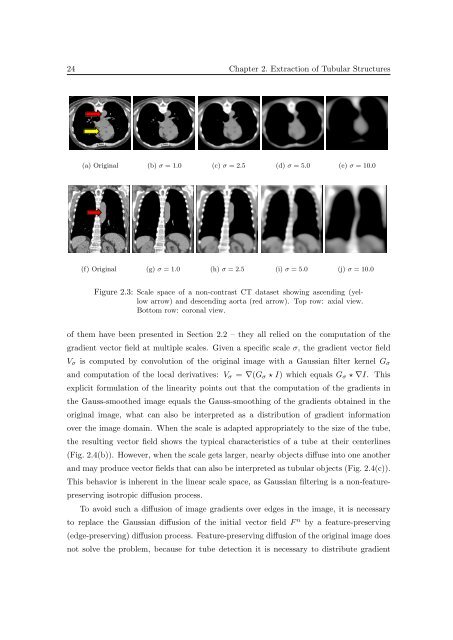Segmentation of 3D Tubular Tree Structures in Medical Images ...
Segmentation of 3D Tubular Tree Structures in Medical Images ...
Segmentation of 3D Tubular Tree Structures in Medical Images ...
You also want an ePaper? Increase the reach of your titles
YUMPU automatically turns print PDFs into web optimized ePapers that Google loves.
24 Chapter 2. Extraction <strong>of</strong> <strong>Tubular</strong> <strong>Structures</strong><br />
(a) Orig<strong>in</strong>al (b) σ = 1.0 (c) σ = 2.5 (d) σ = 5.0 (e) σ = 10.0<br />
(f) Orig<strong>in</strong>al (g) σ = 1.0 (h) σ = 2.5 (i) σ = 5.0 (j) σ = 10.0<br />
Figure 2.3: Scale space <strong>of</strong> a non-contrast CT dataset show<strong>in</strong>g ascend<strong>in</strong>g (yellow<br />
arrow) and descend<strong>in</strong>g aorta (red arrow). Top row: axial view.<br />
Bottom row: coronal view.<br />
<strong>of</strong> them have been presented <strong>in</strong> Section 2.2 – they all relied on the computation <strong>of</strong> the<br />
gradient vector field at multiple scales. Given a specific scale σ, the gradient vector field<br />
V σ is computed by convolution <strong>of</strong> the orig<strong>in</strong>al image with a Gaussian filter kernel G σ<br />
and computation <strong>of</strong> the local derivatives: V σ = ∇(G σ ⋆ I) which equals G σ ⋆ ∇I. This<br />
explicit formulation <strong>of</strong> the l<strong>in</strong>earity po<strong>in</strong>ts out that the computation <strong>of</strong> the gradients <strong>in</strong><br />
the Gauss-smoothed image equals the Gauss-smooth<strong>in</strong>g <strong>of</strong> the gradients obta<strong>in</strong>ed <strong>in</strong> the<br />
orig<strong>in</strong>al image, what can also be <strong>in</strong>terpreted as a distribution <strong>of</strong> gradient <strong>in</strong>formation<br />
over the image doma<strong>in</strong>. When the scale is adapted appropriately to the size <strong>of</strong> the tube,<br />
the result<strong>in</strong>g vector field shows the typical characteristics <strong>of</strong> a tube at their centerl<strong>in</strong>es<br />
(Fig. 2.4(b)). However, when the scale gets larger, nearby objects diffuse <strong>in</strong>to one another<br />
and may produce vector fields that can also be <strong>in</strong>terpreted as tubular objects (Fig. 2.4(c)).<br />
This behavior is <strong>in</strong>herent <strong>in</strong> the l<strong>in</strong>ear scale space, as Gaussian filter<strong>in</strong>g is a non-featurepreserv<strong>in</strong>g<br />
isotropic diffusion process.<br />
To avoid such a diffusion <strong>of</strong> image gradients over edges <strong>in</strong> the image, it is necessary<br />
to replace the Gaussian diffusion <strong>of</strong> the <strong>in</strong>itial vector field F n by a feature-preserv<strong>in</strong>g<br />
(edge-preserv<strong>in</strong>g) diffusion process. Feature-preserv<strong>in</strong>g diffusion <strong>of</strong> the orig<strong>in</strong>al image does<br />
not solve the problem, because for tube detection it is necessary to distribute gradient















